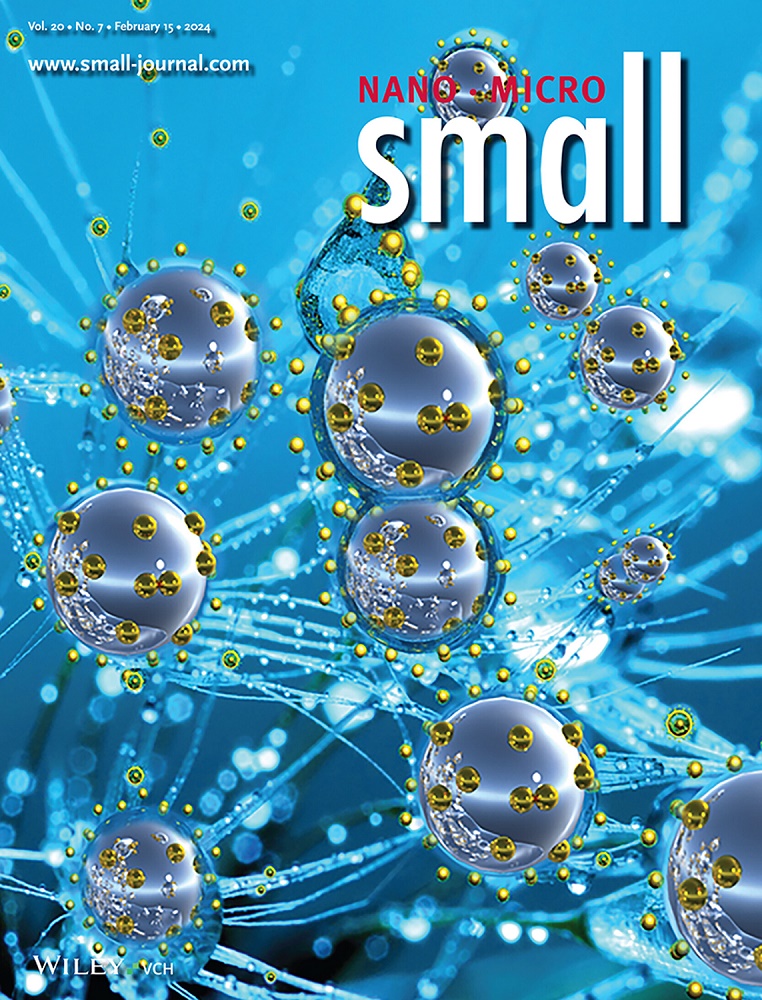溶剂引发的聚集诱导的手性Salen金属大环圆极化发光的反转和增强
IF 12.1
2区 材料科学
Q1 CHEMISTRY, MULTIDISCIPLINARY
引用次数: 0
摘要
自组装金属大环可以作为多功能平台制备功能材料。结合可预测的结构设计,它们允许嵌入广泛的属性。报道了一系列结合手性、聚集诱导发射(AIE)和旋向反转的双核环M2R (M = Zn(II), Co(II/III), R =双salen大环)。模块化系统由三个组成部分组成:i)四苯基乙烯(TPE)骨架,ii)手性salen配位环境,以及iii)螯合过渡金属离子。其热学性质受金属离子、溶剂和聚集程度的影响,分子间堆积的增加导致发射强度的增加。大周期的聚集导致圆二色性(CD)信号的增强和反转,对于Zn2R,圆偏振发光(CPL)的增强和反转,|glum|上升了一个数量级。通过NMR、FT-IR、ESI-MS和三个单晶x射线结构对金属环进行了表征。采用动态光散射(DLS)、扫描电子显微镜(SEM)和计算对聚集体进行了研究,显示出手性组分控制的螺旋扭曲纤维。获得对热学特性的刺激响应控制有助于智能光学材料和传感器的发展。本文章由计算机程序翻译,如有差异,请以英文原文为准。

Solvent-Triggered Aggregation-Induced Reversal and Enhancement of Circularly Polarized Luminescence in Chiral Salen Metalla-Macrocycles
Self-assembled metalla-macrocycles can serve as versatile platforms to prepare functional materials. Combined with a predictable structural design, they allow for the embedding of a broad range of properties. A series of dinuclear rings M2R (M = Zn(II), Co(II/III), R = bis-salen macrocycle) is reported, which combine chirality with aggregation-induced emission (AIE) and chiroptical sign reversal. The modular system forms from three building blocks: i) tetraphenylethylene (TPE) backbones, ii) chiral salen coordination environments, and iii) chelated transition metal ions. The chiroptical properties are modulated by the choice of metal ion, solvent, and the degree of aggregation, with growing intermolecular stacking leading to an increase of the emission intensity. Aggregation of the macrocycles leads to intensification and inversion of the circular dichroism (CD) signal, and, for Zn2R, of the circularly polarized luminescence (CPL), with |glum| rising by one order of magnitude. The metalla-macrocycles are characterized by NMR, FT-IR, and ESI-MS methods and three single-crystal X-ray structures. Dynamic light scattering (DLS), scanning electron microscopy (SEM), and computations are employed to examine the aggregates, showing helically twisted fibers whose handedness is controlled by the chiral component. Gaining stimuli-responsive control over chiroptical properties contributes to new opportunities for the development of smart optical materials and sensors.
求助全文
通过发布文献求助,成功后即可免费获取论文全文。
去求助
来源期刊

Small
工程技术-材料科学:综合
CiteScore
17.70
自引率
3.80%
发文量
1830
审稿时长
2.1 months
期刊介绍:
Small serves as an exceptional platform for both experimental and theoretical studies in fundamental and applied interdisciplinary research at the nano- and microscale. The journal offers a compelling mix of peer-reviewed Research Articles, Reviews, Perspectives, and Comments.
With a remarkable 2022 Journal Impact Factor of 13.3 (Journal Citation Reports from Clarivate Analytics, 2023), Small remains among the top multidisciplinary journals, covering a wide range of topics at the interface of materials science, chemistry, physics, engineering, medicine, and biology.
Small's readership includes biochemists, biologists, biomedical scientists, chemists, engineers, information technologists, materials scientists, physicists, and theoreticians alike.
 求助内容:
求助内容: 应助结果提醒方式:
应助结果提醒方式:


